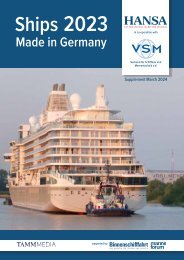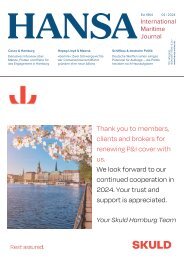HANSA 06-2019
Reparatur & Umbau | Start-Ups | COMPIT Review | CIMAC 2019 | Terminaltechnik | Batterien & Hybrid | Offshore-Flotte | U.A.E. | Cruise Ship Interiors | Zeaborn & Offen
Reparatur & Umbau | Start-Ups | COMPIT Review | CIMAC 2019 | Terminaltechnik | Batterien & Hybrid | Offshore-Flotte | U.A.E. | Cruise Ship Interiors | Zeaborn & Offen
Sie wollen auch ein ePaper? Erhöhen Sie die Reichweite Ihrer Titel.
YUMPU macht aus Druck-PDFs automatisch weboptimierte ePaper, die Google liebt.
Offshore<br />
OSV reactivation and its challenges<br />
Owners of offshore support vessels considering reactivation of laid up assets must satisfy<br />
multiple safety and operational issues before class is restored<br />
Increased demand for production units<br />
means there are some positive signs<br />
from the OSV market, leading to increased<br />
reactivations of laid-up vessels as<br />
new and delayed contracts are awarded.<br />
While not all of these vessels will re-enter<br />
the active fleet, the topic of reactivation<br />
has become more popular as the recovery<br />
in the oil price continues and operators<br />
seek to position themselves to capture<br />
the potential upside.<br />
Asset owners need to carefully consider<br />
their options before reactivation.<br />
Among the issues to be considered are<br />
the vessel’s age and its level of quality<br />
in terms of equipment and technology;<br />
whether it is warm or cold stacked also<br />
drives the decision. Reactivation is ultimately<br />
an economic choice for the owner<br />
and is likely to be based on the cost of<br />
the process versus the length of a potential<br />
service contract. Lead times are short<br />
because multiple vessels are in competition<br />
for the same work and the degree of<br />
readiness can vary widely.<br />
Different owners will have applied varying<br />
levels of technical capability during<br />
the lay-up and whether this process is<br />
done with a reactivation plan, as well as<br />
the quality of the preservation itself will<br />
have an impact. Financial risks include<br />
the total cost of work to be done, including<br />
transportation of teams to the facility<br />
to perform the work or to the vessel. The<br />
reactivation timescale can include the<br />
availability of materials, the readiness of<br />
class, flag and vendors to support as well<br />
as software and automation plans.<br />
Modern OSVs can include complex<br />
technology such as dynamic positioning,<br />
power management and control systems<br />
which must be brought up to date. Software<br />
must be upgraded and IT systems<br />
will need new cyber security measures.<br />
Structural issues can include hull condition,<br />
corrosion, wastage and the replacement<br />
of parts. It is not unusual to<br />
find doors and hatches rusted and corroded<br />
and general corrosion on deck, in<br />
ventilators and air pipes.<br />
Damen Shipyards built the »Bibby Wavemaster Horizon«<br />
The vessel must be checked for unapproved<br />
modifications and replacement<br />
of outdated or missing parts. The owner<br />
must understand the duration of the survey,<br />
whether to undertake a Failure Mode<br />
Effect Analysis and whether the vessel will<br />
require an audit under the International<br />
Safety Management Code, or the International<br />
Ship and Port Facility Security<br />
Code. An interim audit will be required<br />
by the vessel’s flag state if the unit has been<br />
laid up for more than six months.<br />
In the years since the downturn in<br />
the oil price, OSV operators have lost<br />
more than vessel capacity. In many cases<br />
they also lost people, a base of technical<br />
knowledge and expertise that could be vital<br />
to restarting vessel operations. This is<br />
the technical void that class aims to fill.<br />
© Damen Shipyards<br />
A new Esvagt trio will be delivered in 2020-2021<br />
© Esvagt<br />
Key factor wind farm development<br />
Developers of offshore windfarms face a<br />
number of challenges in addition to the<br />
environment in which they are constructed.<br />
These include the regulatory regime<br />
that lays out strict rules on cabotage trade<br />
and safety requirements that encourage<br />
the concept of ‘walk to work’ for technical<br />
teams working on the construction and<br />
during subsequent maintenance.<br />
New wind farm development is also<br />
driving the flexibility of vessels that support<br />
installation, operation and mainte-<br />
76 <strong>HANSA</strong> International Maritime Journal <strong>06</strong> | <strong>2019</strong>


















